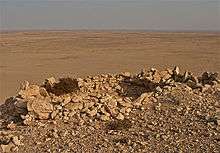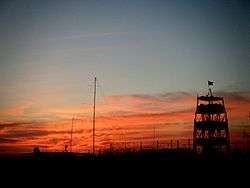Sangar (fortification)

A sangar (or sanger) (Persian: سنگر) is a temporary fortified position with a breastwork originally constructed of stones,[1] and now built of sandbags and similar materials.[2] Sangars are normally constructed in terrain where the digging of trenches would not be practicable. The term is still frequently used by the British Army.
The word was adopted from Hindi and Pashto and derives originally from the Persian word sang, "stone".[3] Its first appearance in English (as recorded by the Oxford English Dictionary) is in the form sunga, and dates from 1841.[4]
Traditional usage
The term was originally used by the British Indian Army to describe small temporary fortified positions on the North West Frontier and in Afghanistan. It was widely used by the British during the Italian Campaign of World War II.[5]
Modern usage

More recently, the use of the term has been extended to cover a wider range of small, semi-permanent fortified positions. The Independent Monitoring Commission stated immediately after The Troubles in Northern Ireland:
The British Army use other terms to classify their sites covered by our definition [of towers and observation posts]. For the avoidance of any doubt we set out below the military terms we have deemed to be included in this part of the report.
- Sangar: A sangar is a protected sentry post, normally located around the perimeter of a base. Its main function is to provide early warning of enemy/terrorist activity/attack in order to protect forces both within the base and those deployed within sight of the sangar.
- Supersangar: A supersangar is an elevated sangar and may be indistinguishable from what is commonly termed a tower.
- Observation Post: An observation post is an installation whose primary role is to collect information, as directed by and in support of the Police Service of Northern Ireland.
- Remote Communications Site: A site used primarily for electronic communications.
— Independent Monitoring Commission[6]
See also
References
- ↑ 'Afridi Picket near to Jumrood', 1878
- ↑ Mark Nicol War in Afghanistan: Britain's Vietnam, Daily Mail 1 October 2006. See section "They could not see properly"
- ↑ Garland Hampton Cannon, Alan S. Kaye. The Persian contributions to the English language: an historical dictionary, p. 126. Otto Harrassowitz Verlag, 2001. ISBN 978-3-447-04503-2
- ↑ "sangar, n.". Oxford English Dictionary (3rd ed.). Oxford University Press. September 2005. (Subscription or UK public library membership required.) (subscription required)
- ↑ Parker, Matthew (2004). Monte Cassino: The Hardest-Fought Battle of World War II. New York: Doubleday. pp. 133, 170, 184, 201, 237, 258, 277. ISBN 0-385-50985-5.
- ↑ Second Report of the Independent Monitoring Commission p. 44. Presented under Article 5(2) of the International Agreement establishing the Independent Monitoring Commission, Ordered by the House of Commons to be printed 20th July 2004
External links
| Wikimedia Commons has media related to Sangars. |
- "Army dismantles NI post". BBC News. 31 July 2000. Retrieved 13 August 2016. Article on the dismantling of the Borucki Sangar at Crossmaglen in south Armagh.
- "Security, surveillance and 'Super Sangars'". MOD Website. 18 September 2008. Archived from the original on 6 April 2010. Retrieved 25 March 2010.
- "The Expeditionary Elevated Sangar". Think Defence. 23 December 2012. Retrieved 13 August 2016. . A description and photographs of British Army Sangars.